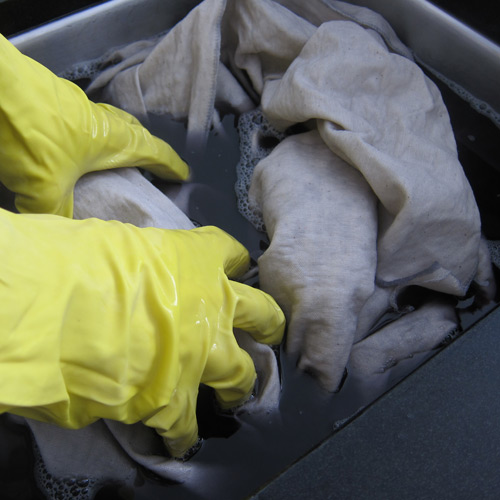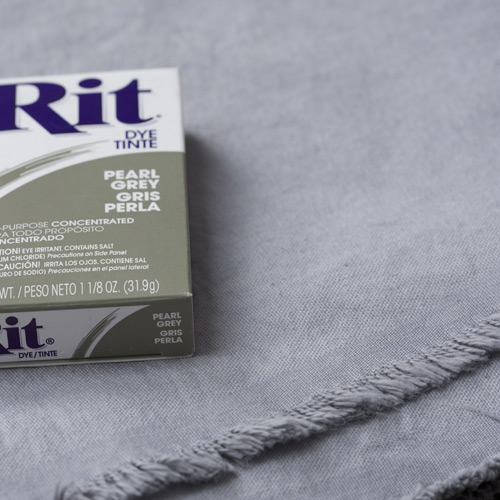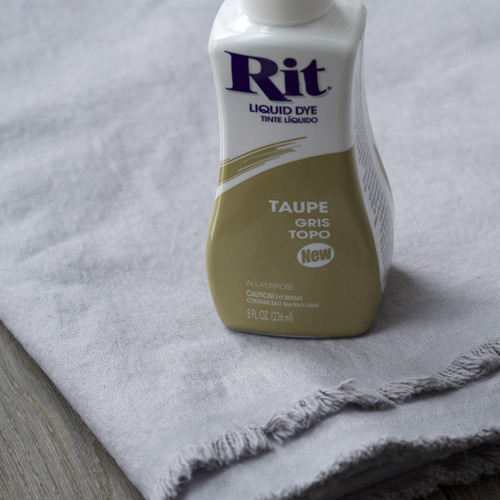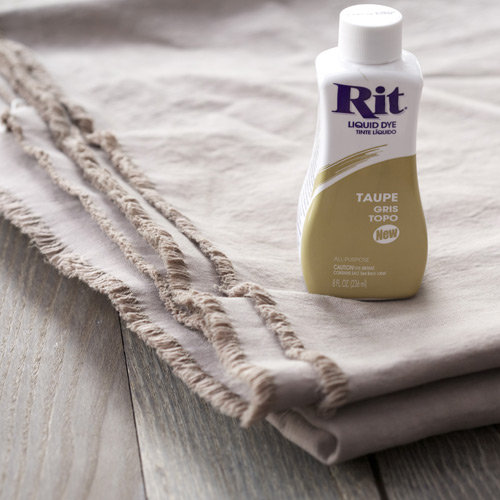Canvas Dying
I bought a couple of yards of canvas on sale knowing that I wanted to make a canvas backpack at some point. When it actually came time to make the backpack (post coming soon), I realized that the natural canvas color would quickly get really dirty. I’ll just dye it I thought, it’s easy right?
The process is actually pretty easy. The hard part is getting the right color. This was my first time dying anything, and while it was fun, I’ll probably look a little harder for the exact color of fabric I want next time, rather than trying to dye fabric to a certain color. I used a simple, inexpensive dye that you can find at most hobby/craft stores.
*Please note, this post is not meant as an endorsement for Rit dye. It just happened to be the easiest product to find in my area.*

I started with a grey powder dye. If the first dying session had resulted in the color shown on the box, I would have been pretty happy with the outcome.

Unfortunately, the result was a very cool light grey, borderline lavender color. Not exactly what I had in mind for a backpack. I followed the instructions, used two packages of dye, washed the fabric before I started, etc. Maybe my water wasn’t hot enough? Maybe my sink was too small? I’m not sure what went wrong, but I’ll blame my lack of experience rather than the dye.

So…I switched to liquid dye, picked out a “nice” taupe color and repeated the process.

My lavender canvas turned into the color shown below, which is actually fairly close to the color on the bottle, and not a bad choice for a backpack. If I do decide to embark on a dying adventure again, I think I’ll try to seek out a non-conventional, more organic approach and use something like coffee or tea to give plain cotton some color. This will do for now.

I hope to have the backpack I made with this canvas up soon.


No, Rit frequently comes out both weak and “off”. I overdyed some fabric with black and navy blue and ended up with a funereal purple. It was a nice color, but it wasn’t what I’d meant to achieve. It’s the dye, not you.
Can’t wait to see your backpack. I’ve been wanting to make something out of canvas and try my hand at waterproofing it with wax.
Good to know I’m not the only one who experienced off colors.
Taylor
Hi Becky,
I actually waxed my backpack just like you mentioned, although I’m not sure how waterproof the canvas is since I used a light layer of wax.
Taylor-
I had similar experiences with RIT just recently. I’m going to experiment with jacquard iDye and see if I get better results.
Would love to see more posts from you, even if you started a tumblr with contextless pics of what you’re sewing and doing!
Drew.
Drew,
I’d love to post more too! Since February I’ve been working on a huge non-blog related project that is over now, so hopefully I will have more time for the blog. I may decide to include my other hobby here as well. I’ve been learning how to brew beer, and may make that a section of the blog.
A while back I did sign up for a TaylorTailor tumblr account, so I’ll have to think about that. I haven’t done anything with it yet.
Taylor
I’m with Drew. Also, would be very curious to read about your beer craft experiences, as I think my husband and I might try that in a couple years.
As for dyes – RIT is generally terrible. For cotton and similar I’d recomend getting fiber reactive dyes. More work is involved, but you actually get the color advertised. I use Dharma Trading when buying dyes, but you can buy them a number of other places.
(link to dharma trading: http://www.dharmatrading.com/html/eng/3796-AA.shtml?lnav=dyes.html)
Looking forward to the backpack.
Hi Anne,
Thanks for the link. I’ll have to check out Dharma Trading if I decide to dye more fabric in the future. Brewing is a lot of fun. I’m relatively new to it, just bottled my 8th batch this past weekend, but glad to hear you would be interested in seeing some brewing posts too.
Taylor
T,
Taylor’s Tailor-made Beer…
Bespoke beer…
I think it would fit perfectly with your blog! Please do show.
Drew.
Can’t wait to see the back pack! Will you sellmcanvas in your shop too?
Jeremy,
If enough people are interested, I would stock canvas in the shop. Canvas is much easier for people to find than selvedge denim though, so I’m not sure if it would sell. Many fabric stores sell it, as well as army surplus type stores. Good idea, I’ll think about it.
Taylor
When I dye fabrics with Rit I always use the washing machine on the hottest setting and follow the instructions exactly. The first time I used Rit in the washing machine I was sure it would ruin the washer but I had no problems. The key with Rit (or any dye) is agitation. If you’re dying a fabric that has a finish or appears to be heavily starched it is best to wash it first to remove the finish. Also if your fabric has poly or another man-made fiber it will not take the dye as well. I work in the costume shop of the Indiana Repertory Theatre and we use Rit quite often and it has always worked as well as more expensive dyes. I think you should give it another chance!
Thanks for the tips Jerry! I was also worried about ruining the washing machine, which is why I went for the sink. This was my first (and second) time using Rit, and blame my lack of experience more than anything.
Taylor
I was just about to post Dharma Trading’s link when I saw Anne’s post. She’s spot on.
The other thing about Rit dyes is, no matter how many times you wash the item, it will get lighter every time. The dyes also bleed if they get damp from rain or, particularly, sweat.
While I’m giving unsolicited advice, I’d avoid wearing the backpack with a light colored shirt or jacket.
Thanks for the heads up regarding the the dye bleeding. Would hate to ruin a nice shirt or jacket.
Taylor,
I’ve tried the Rit dye and did it in a sink too. I didn’t want the dye in my washing machine and possibly having some residual dye staining the next load of laundry. The fabric came out just fine. I dissolved some water softener salt pellets we use in our softener system to set the dye. It worked really well. But I don’t like the idea of sending all that dye down the drain.
A blog that I follow had an interesting link to natural dye: http://www.folkfibers.com/blogs/news/6579481-natural-dyes-red-onion-skins
-John
I chose the sink for the same reasons, and also didn’t like that all that dye went down the drain.
Have you tried to dye hemp? I’m wondering what kind of natural dyes would be good for hemp.
Taylor,
I ordered some of the indigo denim, some of the hemp and cotton blends in natural, a heavy all hemp fabric from their sales section, and some hemp webbing. But I haven’t dyed any of the hemp fabrics and the denim is sitting waiting for me to get around for me to make a pair of jeans out of it. So far, my only dye experience has been to garment dye a pair of organic natural colour denim jeans I made. The organic cotton actually took the dye a lot stronger than the colour I was going for. But with repeated washings as I wear them, hopefully they’ll fade to the colour I originally intended. The Hemp Trader’s website has information on how they dye the fabrics. But I think it is on how they are environmentally responsible. I might email them to see if I can find out what sort of dyes they use. I will let you know what I find out.
John,
I’m definitely a lot more interested in hemp after hearing about your experience with it. I like that it is a good option for warmer climates and better for the environment than cotton. I have a stash of cotton fabric to work through first, but will most likely order some hemp or hemp blends for future projects.
My only hesitation is the colors (I know, a small point when everything else is considered). I don’t like bright colors for clothing, but those yellowy, beige fabrics tend to make me look like I’m sick. If there are some good dying options, I’ll be completely sold.
Taylor,
I emailed Hemp Traders and asked them for suggestions on dying hemp fabric. Here’s their response:
Hi John,
Thanks for your order and your letter.
Hemp will dye easily with any dye which will work on cotton. If you are looking for a natural dye, we recommend looking at our Related Links (http://www.hemptraders.com/related_links.php) page. There you will find suppliers of natural dyes and a natural dye house.
Lawrence Serbin
Hemp Traders
——————————–
I looked around and there are a few places that sell natural dyeing ingredients and kits too. Natural dyes need mordants and assists to effectively adhere their pigments to the fibers of the fabric. Basically all are either metals, acids or alkalies. Alum is the only one I would store in a kitchen cabinet. The main mordants appear to be either Alum (Potassium Aluminum Sulfate), Iron (Ferrous Sulfate), Tin (Stannous Chloride) and/or Blue Vitriol (Copper Sulfate) all of which are toxic. Alum is the safest and is utilized in pickling foods.
All in all, it’s a lot of work and it’s still is a toxic process to dye fabric.
-John
Thanks for the update John. I was hoping for an easy non-toxic way to dye hemp (or organic cotton). I might have to settle for less color fast methods for now. I’ll let you know if I learn anything new once I decide to do it.
Taylor-
Actually…Dharma’s fiber reactive dyes are so much less work than RIT, it’s amazing. All you need is a tub of cold water, the dye, and soda ash (which Dharma also sells–it’s cheap!) to get permanent results. Prewet the fabric, measure out the dye and soda ash, and then all you have to do is stir the fabric from time to time and then rinse it. It’s substantially less toxic than a lot of traditional/”natural” dyes.
Also, be aware that a lot of the information on dyes and mordants is for protein fibers (wool, silk, etc). Cellulose fibers from cotton, linen, hemp, etc, have completely different chemistry. The only real exception are “substantive dyes” like tea and coffee, which need no mordant but also don’t produce super permanent, lightfast, washfast results the way fiber reactive dyes do. Oh, and indigo, but indigo dyeing is a whooooole other kettle of fish that you probably want to avoid if you’re not going to become a serious dyer.
Thanks for your input Willa. I actually just purchased some of Dharma’s fiber reactive dye, soda ash, detergent, etc., and plan on dying some hemp/cotton blend jersey for some t-shirts I’m making. I’m looking forward to the process and hope the color turns out the way I envision.
hey taylor im thinking of making a russian style military kit bag/molle stylethat i can attach to a molle tactical vest i was wonderiing what would be the best material and dye(needs to be grey)and how easy should it be to make one and how much should it cost
I’m not all that familiar with tactical gear, the materials from which that type of gear is made, or construction methods. Obviously the fabric needs to be really tough. A natural fabric choice would be heavy canvas, but I’m guessing they use some type of synthetic fiber such as woven nylon, at least on the vest.
Choose your fabric (natural or synthetic first) and know exactly what type of fibers make up the fabric. You need completely different types of dyes for natural fibers like cotton and hemp, vs. synthetics like nylon and polyester.
I really can’t estimate cost, as I’ve never made anything like that before.
ok ill keep that in mind thanks
Hey Taylor!! I am interested in making my enclosed patio’s drapes out of canvas drop cloth. However, I would really like to go with an actual color. Since its outdoors ( mostly shaded ) I would like some recommendations on dying my canvas ahead of time? Help, please!! Thanks in advance!
Hi Hope,
If you are dying something that large, it will be difficult to get consistent coloring throughout the drop cloth unless you have a huge tank for the dying process. If you don’t mind inconsistent color, then give it a shot. The more the fabric can move freely during the dying process, the better the results. Definitely wash the drop cloth before dying, and make sure it is 100% cotton if you are using natural fiber dye.
Rit Dye has dying formulas online if you’re interested. I got a beautiful olive drab bag accidentally by mixing brown, 2 greens & black together with salt to make it permanent!
You might want to try this option.
Taylor,
Do you have any suggestions for dying canvas drop black? After multiple tries to achieve black the color is a faint gray color. Should I dye the canvas another color first, then try dying it black?
Hi LaNiece,
Sorry, I don’t have any experience trying to dye anything black. I know that highly saturated colors can be difficult.
Add 1 tablespoons of salt for the bottle of rit dye or 1/2 tablespoon per packet . There is also a powder you can purchase called soda ash that makes the colors more vibrant and I have found that to work very well!!
I was delighted to find your post😊 as I want to dye canvas for a dog bed & your first pic of the gray was exactly the color I am looking to achieve. Thank you so much👍